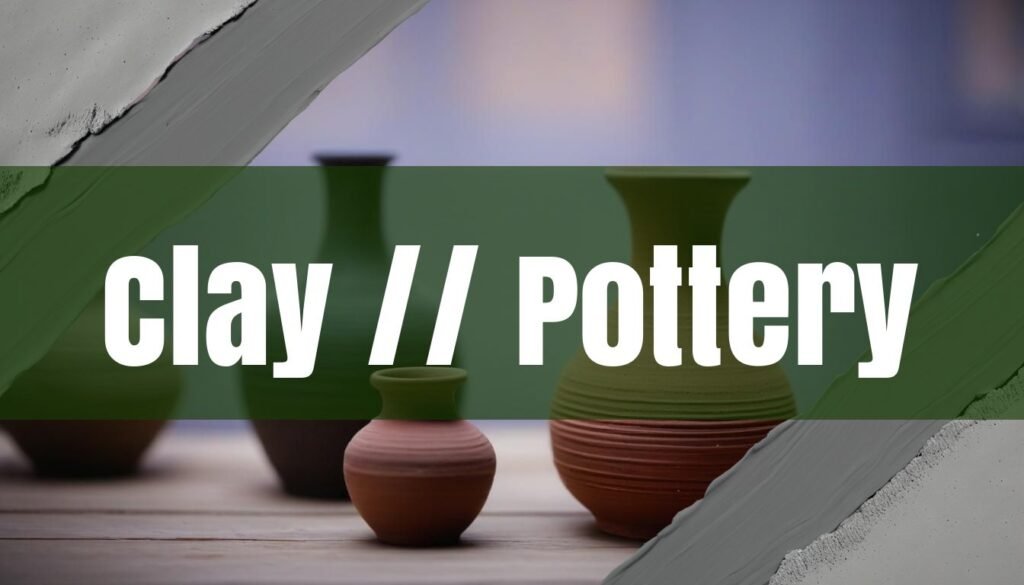Choosing the right clay for pottery is a foundational step in bringing your creative visions to life. The world of pottery offers a diverse palette of clay types, each possessing unique characteristics that cater to different skill levels, aesthetic preferences, and functional requirements. Whether you’re a beginner just starting to explore the tactile joys of hand-building or an experienced potter seeking the perfect medium for intricate wheel-thrown pieces, understanding the properties of various clays is essential. This article will guide you through the most popular types of clay used in pottery: earthenware, stoneware, and porcelain, along with a glimpse into specialty clays. We’ll delve into their firing temperatures, typical applications, advantages, and disadvantages, equipping you with the knowledge to select the ideal clay for your next ceramic adventure. The world of pottery offers a diverse palette of clay types.
Earthenware, Stoneware, and Porcelain: A Closer Look
Earthenware clay is often celebrated as the most ancient type of clay used by potters. Its appeal lies in its high plasticity and ease of manipulation, making it a favorite among beginners. Its appeal lies in its high plasticity and ease of manipulation. Characterized by its composition of iron and mineral impurities, earthenware typically matures at a firing temperature between 950°C and 1,100°C (approximately 1,745°F and 2,012°F). Earthenware typically matures at a firing temperature between 950°C and 1,100°C. After firing, earthenware remains porous unless glazed, rendering it suitable for plant pots and other decorative items not intended to hold liquids. This clay is known for its vibrant colors and compatibility with various glazes, allowing for colorful experimentation. This clay is known for its vibrant colors. Because earthenware clay is generally easier for potters to work with and is more forgiving, it makes it a popular choice for beginner potters. Earthenware clay is generally easier for potters to work with.
Stoneware clay stands out for its robustness and versatility, making it ideal for functional pottery. Often appearing white or grey when wet, stoneware contains mineral impurities like silica, feldspar, ball clay, and quartz, contributing to its durability. Stoneware contains mineral impurities like silica, feldspar, ball clay, and quartz. Fired at higher temperatures, typically between 1000°C and 1380°C (2,000° to 2,400° F) stoneware becomes stone-like, non-porous, and capable of holding liquids and foodstuffs. Stoneware becomes stone-like, non-porous, and capable of holding liquids and foodstuffs. Potters can also make stoneware with multiple different clay colors today. Potters can also make stoneware with multiple different clay colors today. Its coarser texture is well-suited for both wheel-throwing and hand-building techniques, offering a broad canvas for various glazes and surface treatments. Stoneware is a reliable choice for creating enduring pieces due to its high firing temperatures. Stoneware is a reliable choice for creating enduring pieces. You may also be interested in Crafting Everyday Pottery: Clay, Glaze, and Firing Essentials.
Porcelain is often regarded as the pinnacle of ceramic artistry. Its pure composition, primarily kaolin, gives it a characteristic white color and allows it to achieve a translucent finish when fired at high temperatures. Its pure composition, primarily kaolin, gives it a characteristic white color. Porcelain clay is sometimes known as kaolin as this is what it is made of. Porcelain clay is sometimes known as kaolin. The three types of porcelain ceramics are hard-paste, soft-paste, and bone china. The three types of porcelain ceramics are hard-paste, soft-paste, and bone china. Because of its fine texture and demanding nature, porcelain requires a high degree of skill and experience to work with effectively. Porcelain requires a high degree of skill and experience to work with effectively. It is favored for creating refined and intricate pieces, such as fine art sculptures, delicate tableware, and bright white pottery. Porcelain is favored for creating refined and intricate pieces. More information can be found A Journey Through Time: The Story of Chinese Porcelain.
Beyond the Basics: Specialty Clays and Preparation
Beyond the primary categories of earthenware, stoneware, and porcelain, there exists a range of specialty clays tailored for specific purposes. Ball clays, known for their extreme plasticity, are often added to other clay bodies to enhance workability. Ball clays, known for their extreme plasticity, are often added to other clay bodies. Fire clay, with its exceptional heat resistance, is utilized in creating kilns and other high-temperature applications. Fire clay, with its exceptional heat resistance, is utilized in creating kilns. Egyptian paste, also called fritware, is a self-glazing clay body suitable for small beads, sculptures and press-molded forms. Egyptian paste, also called fritware, is a self-glazing clay body suitable for small beads. Air-dry clay is a type of clay that dries and hardens naturally in the air without the need for baking or firing in a kiln. Air-dry clay is a type of clay that dries and hardens naturally in the air. Understanding these specialty clays allows potters to fine-tune their materials for specific projects, expanding the possibilities of ceramic art.
Before any clay can be used, proper preparation is key. Wedging, the process of kneading clay to remove air bubbles and create a uniform consistency, is essential for preventing explosions during firing. Wedging, the process of kneading clay to remove air bubbles and create a uniform consistency, is essential for preventing explosions during firing. Controlling moisture content is also crucial. Clay that is too dry can be difficult to work with, while clay that is too wet may slump or crack. By carefully managing these factors, potters can ensure that their chosen clay performs optimally, leading to successful and satisfying results. By carefully managing these factors, potters can ensure that their chosen clay performs optimally.
Making the Right Choice
Selecting the right clay involves considering several factors. Your skill level plays a significant role; beginners often find earthenware more manageable, while experienced potters may embrace the challenges of porcelain. The desired aesthetic also influences clay choice, as different clays offer unique colors and textures. Functionality is another key consideration; stoneware is ideal for functional pieces due to its durability, while earthenware may be better suited for decorative items. By carefully evaluating these factors and experimenting with different clay types, you can discover the perfect material to bring your artistic vision to fruition. Remember that pottery is a journey of exploration and discovery, so embrace the wobbles, celebrate the triumphs, and enjoy the process of working with clay.





